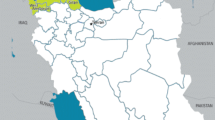Abstract
Genetic diversity was assessed in a buffalo population (Dharwadi) of Karnataka by utilizing 25 heterologous bovine microsatellite markers. Genotypic status of individuals at each locus was identified by automated DNA sequencer, and allelic data were analyzed for genetic diversity parameters. Observed number of alleles varied between 5 and 19 with 13.12 ± 0.80 alleles per locus. High level of heterozygosity (0.63) indicated plenty of existing genetic diversity in this buffalo population. Within-population inbreeding estimate (FIS) was significantly positive (0.186) and 88% of the investigated loci contributed toward the homozygote excess. Accordingly, significant deviation from Hardy–Weinberg equilibrium was observed at 24 of 25 analyzed loci. The population did not suffer reduction in effective population size in the last few generations. Assessment of Dharwadi buffalo population for mutation-drift equilibrium did not reveal significant heterozygosity excess under all the models of microsatellite evolution as per Sign test. No shift was recorded in the frequency distribution of alleles, and a normal L-shaped curve indicated absence of any recent genetic bottleneck. The study highlighted sufficient genetic variability within Dharwadi buffalo population that can be utilized in combination with phenotype and production information for registration as a distinct breed of Indian buffalo.


Similar content being viewed by others
References
Arora R, Lakhchaura BD, Prasad RB, Tantia MS, Vijh RK (2004) Genetic diversity analysis of two buffalo populations of northern India using microsatellite markers. J Anim Breed Genet 121:111–118
Barker JSF (1994) A global protocol for determining genetic distances among domestic livestock breeds. In: 5th world congress on genetics applied to livestock production, pp 501–508
Bhuyan DK, Sangwan ML, Gole VC, Sethi RK (2010) Studies on DNA fingerprinting in Murrah buffaloes using microsatellite markers. Indian J Biotechnol 9:367–370
Cornuet JM, Luikart G (1996) Description and power analysis of two tests for detecting recent population bottlenecks from allele frequency data. Genetics 144:2001–2014
Joshi J, Salar RK, Banerjee P, Sharma U, Tantia MS, Vijh RK (2015) Assessment of genetic variability and structuring of riverine buffalo population (Bubalusbubalis) of Indo-Gangetic basin. AnimBiotechnol 26:148–155
Kathiravan P, Mishra BP, Kataria RS, Goyal S, Tripathy K, Sadana DK (2010) Short tandem repeat based analysis of genetic variability in Kanara buffalo of South India. Russ J Genet 46:988–993
Kathiravan P, Mishra BP, Kataria RS, Sadana DK (2009) Evaluation of genetic architecture and mutation drift equilibrium of Marathwada buffalo population in central India. Livest Sci 121:288–293
Kumar S, Gupta J, Niraj K, Navani N, Jain P, Nagarajan M (2006) Genetic variation and relationships among eight Indian riverine buffalo breeds. Mol Ecol 15:593–600
Mishra BP, Kataria RS, Bulandi SS (2009) Riverine status and genetic structure of Chilika buffalo of eastern India as inferred from cytogenetic and molecular marker-based analysis. J Anim Breed Genet 126:69–79
Peakall R, Smouse PE (2008) A heterogeneity test for fine-scale genetic structure. Mol Ecol Notes 17:3389–3400
Peery MZ, Kirby R, Reid BN, Stoelting R, Doucet-Bëer E, Robinson S, Vásquez-Carrillo C, Pauli JN, Palsbøll PJ (2012) Reliability of genetic bottleneck tests for detecting recent population declines. Mol Ecol 21:3403–3418
Sambrook J, Russell DN (2001) Molecular cloning: a laboratory manual, 3rd edn. Cold Spring Harbor Lab Press, New York
Takezaki N, Nei M (1996) Genetic distances and reconstruction of phylogenetic trees from microsatellite DNA. Genetics 144:389–399
Vijh RK, Tantia MS, Mishra B, Bharani Kumar ST (2008) Genetic relationship and diversity analysis of Indian water buffalo (Bubalusbubalis). J Anim Sci 86:1495–1502
Yeh FC, Boyle T, Yang RC (1999) POPGENE VERSION 1.31: Microsoft Window-based free Software for Population Genetic Analysis, quick user guide. Center for International Forestry Research, University of Alberta, Edmonton, Alberta, Canada
http://dahd.nic.in/dahd/statistics/animal-husbandrystatistics.aspx
Acknowledgements
This study was funded by Network Project on Animal Genetic Resources (Indian Council of Agricultural Research). State Animal Husbandry Department of Karnataka is also acknowledged for their help in blood sampling.
Author information
Authors and Affiliations
Corresponding author
Ethics declarations
Conflict of interest
All authors declare that they have no conflict of interest.
Electronic supplementary material
Below is the link to the electronic supplementary material.
Rights and permissions
About this article
Cite this article
Sharma, R., Ahlawat, S., Sharma, H. et al. Microsatellite-based Genetic Diversity and Mutation-Drift Equilibrium in Dharwadi Buffalo (Bubalus bubalis) of India. Agric Res 8, 553–558 (2019). https://doi.org/10.1007/s40003-018-0396-5
Received:
Accepted:
Published:
Issue Date:
DOI: https://doi.org/10.1007/s40003-018-0396-5




